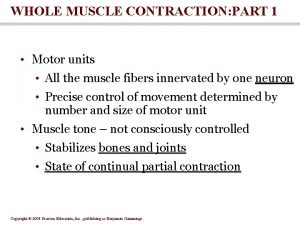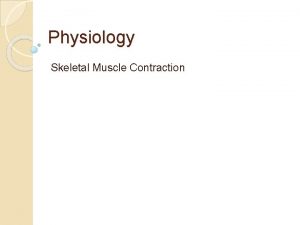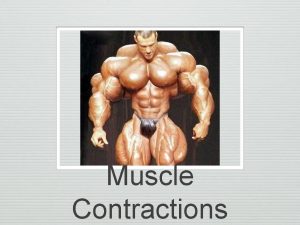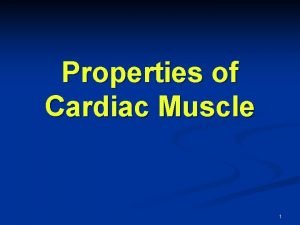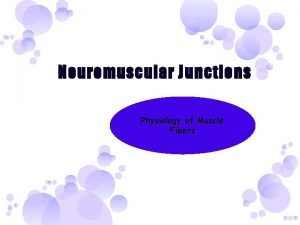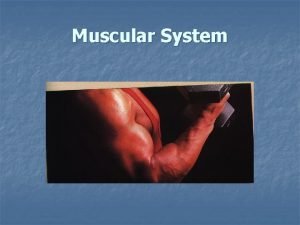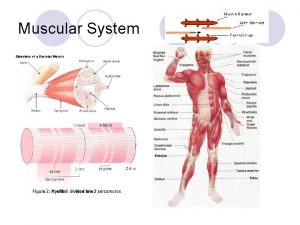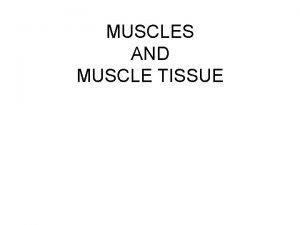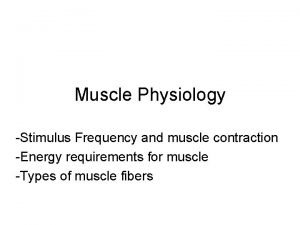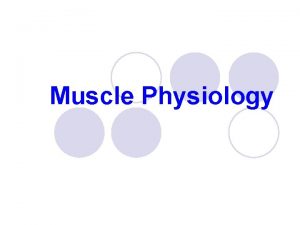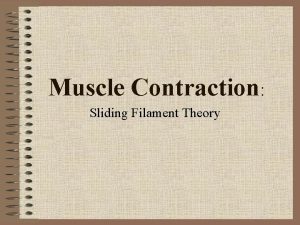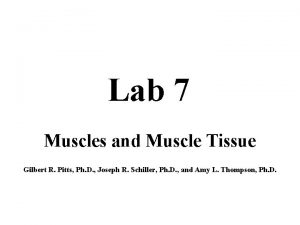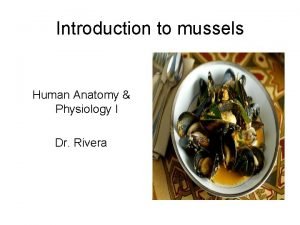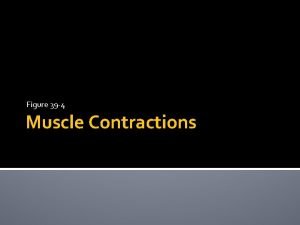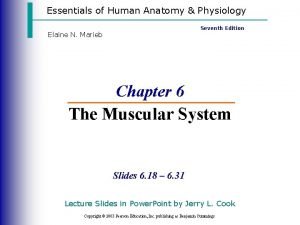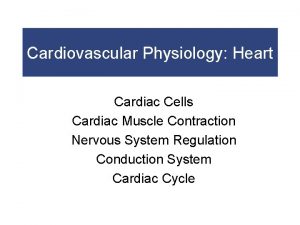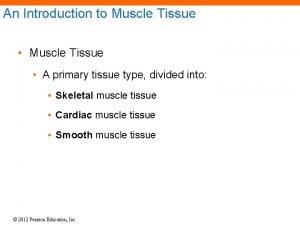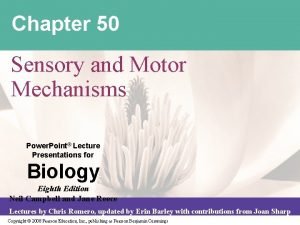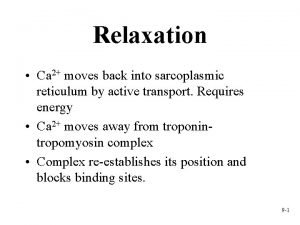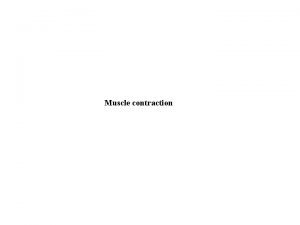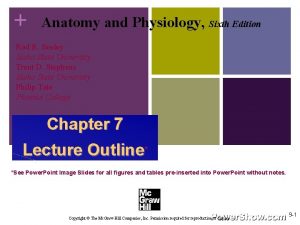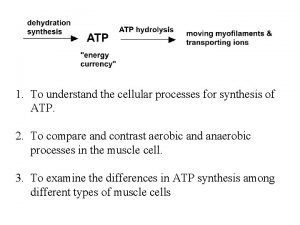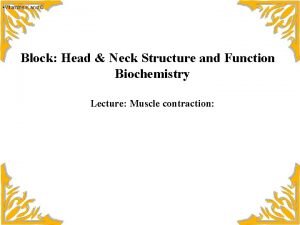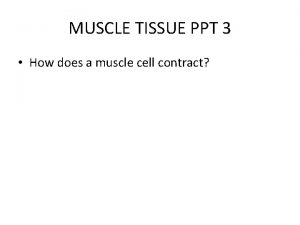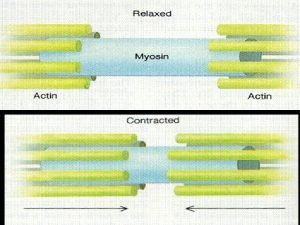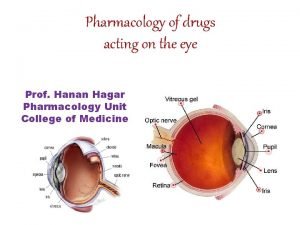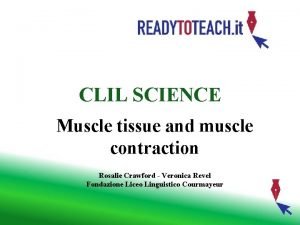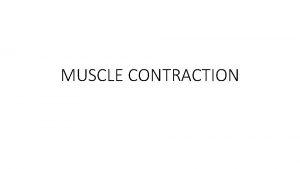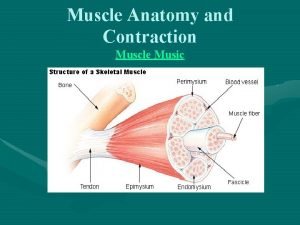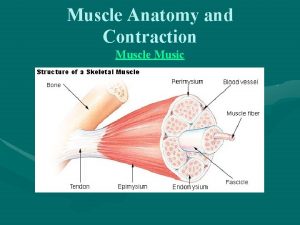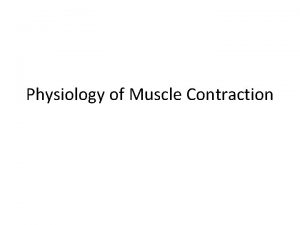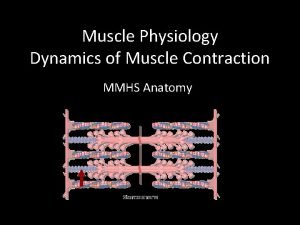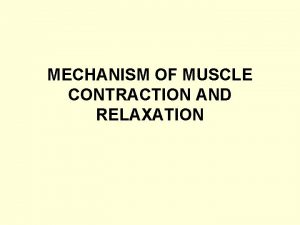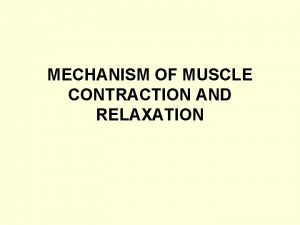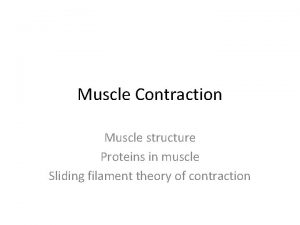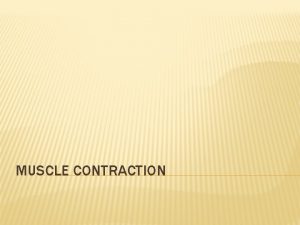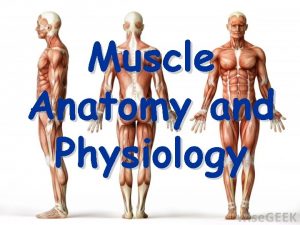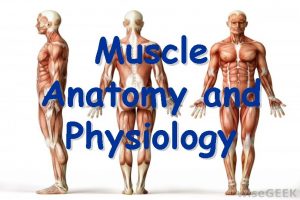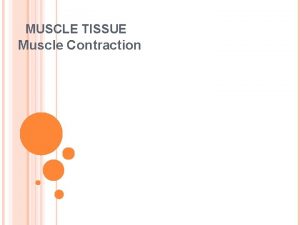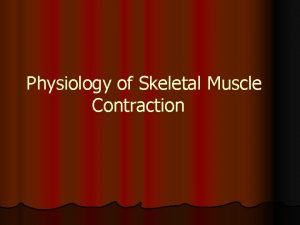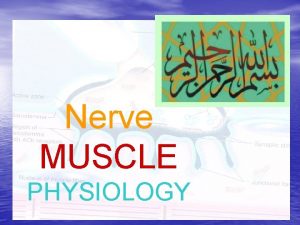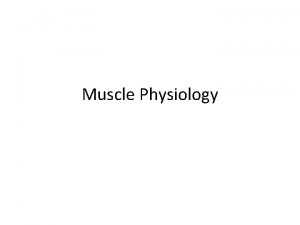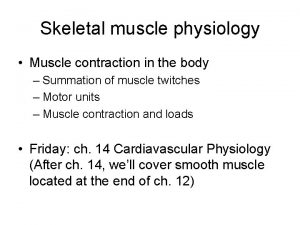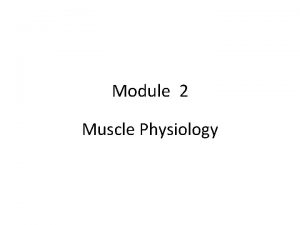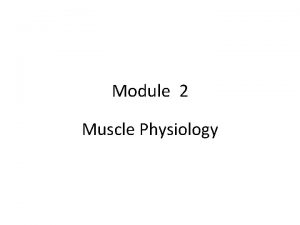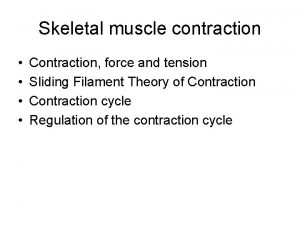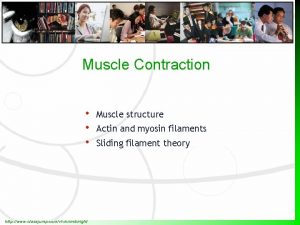Anatomy and Physiology I Muscle Structure and Contraction








































- Slides: 40

Anatomy and Physiology I Muscle Structure and Contraction Part II Instructor: Mary Holman

Fig. 9. 2 Basic Skeletal Muscle Structure Muscle Bone Fascicles Tendon Muscle fibers (cells) Fascia (covering muscle) Epimysium Perimysium Myofibrils Thick and thin filaments Endomysium Fascicle Axon of motor neuron Blood vessel Nucleus Sarcoplasmic reticulum Myofibril Filaments Muscle fiber Sarcolemma Actin Myosin

Fig. 9. 5 a Sarcomere I band A band I band Copyright © The Mc. Graw-Hill Companies, Inc. Permission required for reproduction or display. Z M H zone © H. E. Huxley Z 16, 000 x

Three Types of Protein Associated with the Muscle Fiber • Contractile – Actin – Myosin • Regulatory – Troponin – Tropomyosin • Structural – Titin – Dystrophin – Myomesin – Nebulin

Fig. 9. 5 b Copyright © The Mc. Graw-Hill Companies, Inc. Permission required for reproduction or display. Sarcomere A band Titin I band Z line Thin filaments Actin Thick filaments Myosin

Fig. 9. 6 Thick and Thin Filaments Copyright © The Mc. Graw-Hill Companies, Inc. Permission required for reproduction or display. Myosin heads - Cross-bridges Thin filament Thick filament Thin filament Troponin Tropomyosin Myosin molecule Actin molecule

Fig. 9. 8 c Neuromuscular Junction Copyright © The Mc. Graw-Hill Companies, Inc. Permission required for reproduction or display. Synaptic vesicles Mitochondria Acetylcholine Synaptic cleft Folded sarcolemma

Muscle Fibers innervated by Two Motor Neurons Copyright © The Mc. Graw-Hill Companies, Inc. Permission required for reproduction or display. Motor neuron of motor unit 2 Motor neuron of motor unit 1 Branches of motor neuron axon Skeletal muscle fibers

Events Leading up to Muscle Contraction • Nerve impulse arrives at end of motor nerve axon causing • Acetylcholine (Ach) release into synapse via exocytosis • ACh floods across synaptic gap and attaches to receptors on the sarcolemma • Permeability of sarcolemma changes and Na+ enters cell • A muscle impulse is triggered • Muscle impulse travels via the transverse tubules throughout muscle cell • Ca++ diffuses from SR and binds to troponin on actin • Myosin cross bridges link with actin and muscle contracts

Fig. 9. 9 a Relaxed muscle Copyright © The Mc. Graw-Hill Companies, Inc. Permission required for reproduction or display. Tropomyosin Troponin Thin filament Actin monomers ADP + P Thick filament 1 Muscle contraction begins and continues if ATP is available and Ca++ level in the sarcoplasm is high

Fig. 9 b Muscle Contraction Ca++ released from sarcoplasmic reticulum Ca+2 binds to troponin Copyright © The Mc. Graw-Hill Companies, Inc. Permission required for reproduction or display. Tropomyosin pulled aside ATP Binding sites on actin exposed Ca+2 ADP + P Ca+2 2 Exposed binding sites on actin molecules allow the muscle contraction cycle to occur

Fig. 9. 9 c ADP + P 3 ADP + P Myosin heads bind to actin, forming cross-bridges ADP P ADP + P 4 Cross-bridges pull thin filament (power stroke), ADP and P released from myosin

ATP ATP 5 New ATP binds to myosin, releasing linkages ADP + 6 P ADP + P ATP splits, which provides power to“cock” the myosin cross-bridges

Fig. 9. 10 a Copyright © The Mc. Graw-Hill Companies, Inc. Permission required for reproduction or display. Sarcomere A band Z line 1 Relaxed Thin filaments Thick filaments 2 Contracting 3 Fully contracted

Fig. 9. 10 b Copyright © The Mc. Graw-Hill Companies, Inc. Permission required for reproduction or display. Sarcomere A band Z line EM 23, 000 x © H. E. Huxley

Muscle Fiber Excitation • Nerve impulse arrives at axon terminal • Triggers release of Ach by exocytosis • ACh diffuses across synaptic cleft • ACh binds to receptors on muscle motor end plate • Sarcolemma becomes more permeable to Na+ • Na+ triggers release of muscle action potential • Muscle action potential travels along outside of sarcolemma and into T tubules • Action potential triggers Ca++ release from SR • Ca++ binds to troponin on thin filament • Tropomyosin is pulled aside, revealing binding sites • Myosin links to & pulls actin to contract muscle Muscle Fiber Relaxation • Acetylcholinesterase decomposes ACh in synapse • Action potential (impulse) ends • SR actively pumps Ca++ back into SR • Tropomyosin moves back to cover binding sites • Myosin heads detach • Muscle fiber returns to its longer resting length

Part II Text pgs 302 - 313 Muscle Metabolism Muscle Responses Smooth and Cardiac Muscle

Fig. 9. 11 Energy Sources for Muscular Contraction When cellular ATP is high Creatine P When cellular ADP Creatine ATP is low P Copyright © The Mc. Graw-Hill Companies, Inc. Permission required for reproduction or display. ADP ATP

Immediate ATP from creatine phosphate Creatine ATP ATP Energy for muscle contraction Creatine phosphate ADP Relaxed muscle ADP Contracting muscle P

Short-term ATP from Anaerobic Respiration Muscle glycogen Or From blood Glucose Energy Net gain 2 ATP 2 Pyruvic acid 2 Lactic acid Into blood Copyright © The Mc. Graw-Hill Companies, Inc. Permission required for reproduction or display.

Fig. 9. 12 Oxygen carried from the lungs by hemoglobin in red blood cells is stored in muscle cells by myoglobin and is available to support aerobic respiration. Lactic acid Mitochondria Pyruvic acid Cytosol Long-term ATP is provided by Aerobic Cellular Respiration Citric acid cycle Electron transport chain Synthesis of 34 CO 2 + H 2 O + Energy Heat Copyright © The Mc. Graw-Hill Companies, Inc. Permission required for reproduction or display. ATP

Heat Production • 85% of heat generated in the body is from muscle contraction Muscle Fatigue • Defined as a loss of work out-put leading to reduced performance • Build-up of lactic acid • Depletion of muscle glycogen • Decrease in blood glucose • Increase in body temperature

Oxygen Debt Recovery period - restores pre-exertion metabolic condition • convert lactic acid back into glycogen • resynthesize creatine phosphate • replenish oxygen storage in myoglobin

Force of contraction Fig. 9. 14 Myogram of a single muscle twitch Latent period Period of contraction relaxation Time of stimulation Time

Fig. 9. 15 Force vs Muscle fiber length (a) Optimal length (c) Overly stretched Force (b) Overly shortened Muscle fiber length Copyright © The Mc. Graw-Hill Companies, Inc. Permission required for reproduction or display.

Fig. 9. 16 Force of contraction Increasing Stimulation Frequency Force of contraction (a) Force of contraction (b) (c) Time Copyright © The Mc. Graw-Hill Companies, Inc. Permission required for reproduction or display.

Fast Twitch and Slow Twitch Muscle Fibers Slow-twitch fibers (Type I) Slow to respond, slow to fatigue Fast-twitch glycolytic fibers (Type IIa) Fast to respond, fast to fatigue Fast-twitch fatigue-resistant fibers (Type IIb) Fast to respond, slow to fatigue

Slow-twitch fibers (Type I) Slow to respond - slow to fatigue • Always oxidative • Resistant to fatigue • Red fibers • Most myoglobin • Good blood supply - more capillaries • Lots of mitochondria • Smallest fibers

Fast-twitch glycolytic fibers (Type IIa) Fast to respond - fast to fatique • White fibers (less myoglobin) • Poorer blood supply • Susceptible to fatigue • Largest fibers • Lots of glycogen • Few mitochondria Fast-twitch fatigue-resistant fibers (Type IIb) Fast to respond - slow to fatique • Intermediate fibers • Oxidative • Intermediate amount of myoglobin • Intermediate amount of mitochondria • Pink to red in color • Resistant to fatigue

Fig 9. 17 Muscle Fibers innervated by Two Motor Neurons Copyright © The Mc. Graw-Hill Companies, Inc. Permission required for reproduction or display. Motor neuron of motor unit 2 Motor neuron of motor unit 1 Branches of motor neuron axon Skeletal muscle fibers

Fig. 9. 18 Isotonic Concentric Eccentric Isometric No movement Movement (a) Muscle contracts with force greater than resistance and shortens (concentric contraction) Movement (b) Muscle contracts with force less than resistance and lengthens (eccentric contraction) (c) Muscle contracts but does not change length (isometric contraction) Copyright © The Mc. Graw-Hill Companies, Inc. Permission required for reproduction or display.

Types of Muscle Tissue • Skeletal muscle • General characteristics: • Muscle cells also called muscle fibers • Contractile • Three (3) types: • Skeletal muscle • Smooth muscle • Cardiac muscle • Attached to bones • Striated • Voluntary • Smooth muscle • Walls of organs • Skin • Walls of blood vessels • Involuntary • Non-striated • Cardiac muscle • Heart wall • Involuntary • Striated • Intercalated discs

Fig. 5. 28 Skeletal Muscle Tissue Striations Nuclei Portion of a muscle fiber (a) (b) b: © The Mc. Graw-Hill Companies, Inc. /Al Telser, photographer Copyright © The Mc. Graw-Hill Companies, Inc. Permission required for reproduction or display

Fig. 5. 29 Smooth Muscle Tissue Cytoplasm Nucleus (a) (b) b: © The Mc. Graw-Hill Companies, Inc. /Dennis Strete, photographer Copyright © The Mc. Graw-Hill Companies, Inc. Permission required for reproduction or display

Smooth Muscle Contraction From: Principles of Anatomy & Physiology Tortora & Grabowsky

Fig. 5. 30 Cardiac Muscle Cells Striations Nucleus Intercalated disc (a) desmosome b: © The Mc. Graw-Hill Companies, Inc. /Al Telser, photographer gap junction Copyright © The Mc. Graw-Hill Companies, Inc. Permission required for reproduction or display

Fig. 9. 20 a First-Class Lever Resistance Force (Effort) EFR Force (Effort) Resistance Fulcrum Copyright © The Mc. Graw-Hill Companies, Inc. Permission required for reproduction or display.

Fig. 9. 20 b Second-class Lever Resistance Fulcrum FRE Resistance Force Effort Fulcrum Copyright © The Mc. Graw-Hill Companies, Inc. Permission required for reproduction or display. Force Effort

Fig. 9. 20 c Third-class lever Resistance Force Effort FER Resistance Fulcrum Force - Effort Copyright © The Mc. Graw-Hill Companies, Inc. Permission required for reproduction or display. Fulcrum

Fig. 9. 22 Copyright © The Mc. Graw-Hill Companies, Inc. Permission required for reproduction or display. Coracoid process Origins of biceps brachii Tendon of long head Tendon of short head Biceps brachii Radius Insertion of biceps brachii Origin = Stable bone Insertion = Moveable bone
 Fusiform fibers smooth muscle
Fusiform fibers smooth muscle Site:slidetodoc.com
Site:slidetodoc.com The phenomenon of rigor mortis is a direct result of
The phenomenon of rigor mortis is a direct result of Specialized stems examples
Specialized stems examples Muscle contraction
Muscle contraction Autorythmicity
Autorythmicity All or none principle of action potential
All or none principle of action potential 3 phases of muscle contraction
3 phases of muscle contraction Muscle movement
Muscle movement Muscle spasm
Muscle spasm 3 phases of muscle contraction
3 phases of muscle contraction Incomplete tetanus muscle contraction
Incomplete tetanus muscle contraction Sliding filament theory worksheet
Sliding filament theory worksheet Muscle
Muscle Isotonic exercise
Isotonic exercise Muscle contraction animation mcgraw hill
Muscle contraction animation mcgraw hill Direct phosphorylation
Direct phosphorylation Tetanus vs summation
Tetanus vs summation Membrane potential of cardiac muscle
Membrane potential of cardiac muscle Skeletal muscle contraction steps
Skeletal muscle contraction steps 3 phases of muscle contraction
3 phases of muscle contraction Whole muscle contraction
Whole muscle contraction Phases of muscle contraction
Phases of muscle contraction Contraccion muscular
Contraccion muscular Phases of muscle contraction
Phases of muscle contraction Phases of muscle contraction
Phases of muscle contraction Biochemistry of muscle contraction
Biochemistry of muscle contraction Muscle tissue ppt
Muscle tissue ppt Muscle contraction
Muscle contraction Ciliary muscle contraction
Ciliary muscle contraction Contraction of muscles
Contraction of muscles Upper respiratory tract consists of
Upper respiratory tract consists of Tattoo anatomy and physiology
Tattoo anatomy and physiology Science olympiad anatomy and physiology
Science olympiad anatomy and physiology Bone anatomy and physiology
Bone anatomy and physiology Anatomy and physiology of peptic ulcer
Anatomy and physiology of peptic ulcer Segmental anatomy of the liver
Segmental anatomy of the liver Difference between anatomy and physiology
Difference between anatomy and physiology Hypogastric region
Hypogastric region Anatomy and physiology of blood
Anatomy and physiology of blood The central sulcus divides which two lobes? (figure 14-13)
The central sulcus divides which two lobes? (figure 14-13)

